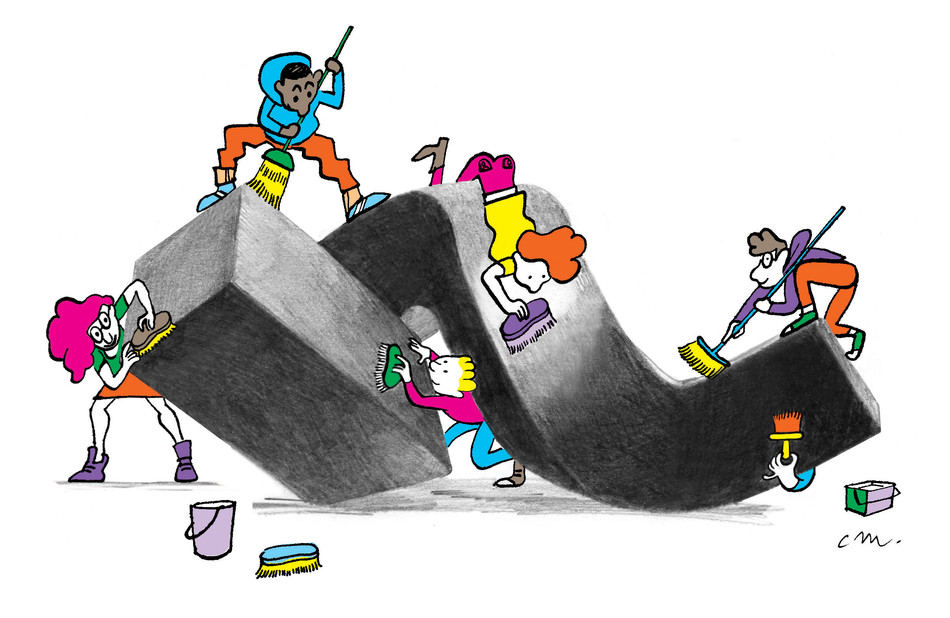On October 25, 1968, at Amsterdam Avenue and West 118th Street below Fayerweather Hall, a red construction crane groaned. Above, people lined the parapet of Avery Plaza and watched as the machine raised its latticed arm, from whose hook hung an improbable hunk of steel. Black, curved, and weighing three tons, it was secured with ropes like a hoisted whale.
Among the spectators was the Australian-born sculptor Clement Meadmore. The massive object being lifted over the parapet was Curl — Meadmore’s first work of public art.
Nearby, Percy Uris ’20CC and Harold Uris, brothers and partners in the Uris Buildings Corporation, followed the trajectory of the dangling abstraction. Percy had commissioned its construction and donated it to Columbia to rest — if a Meadmore sculpture can be said to rest — on the grassy plot in front of Uris Hall, the home of Columbia’s business school.
Curl was twenty-four feet long, twelve feet high, and eleven feet wide. Like many Meadmore sculptures, it had a twisting shape that suggested motion, embodying Meadmore’s statement that “I am interested in geometry as a grammar which, if understood, can be used with great flexibility and expressiveness.”
Percy Uris was not normally associated with modern art, or aesthetics in general. By the 1960s, the Uris Buildings Corporation had redefined the city’s real-estate-development ethos as one of strict efficiency and functionality, spiking the skyline with hotels and apartment houses and office towers that drew criticism in architectural circles for a lack of imagination. “We had a policy of creating the greatest amount of space for the lowest cost,” Harold Uris told the New York Times in 1981. “We hoped we had a pretty building, but we were not building a Taj Mahal. We were interested in making money, and we certainly could not have borrowed any to make something that was not useful.”
With Percy as financial mastermind and Harold managing construction, the brothers built. They built the American Tobacco Company Building, the J. C. Penney Building, the ITT Building. They built the RCA Communications Building and the New York Hilton Hotel. They built 55 Water Street, which upon its completion in 1972 was the largest office building in the world. They built luxury residences on Fifth Avenue, commercial skyscrapers in Midtown, and the wedding-cake-shaped Look Building on Madison Avenue, designed by Emery Roth and Sons (their chief collaborator) and granted landmark status in 2010. And in 1960, they put up three million of the $8.5 million to build Uris Hall, an eight-story concrete building whose 1964 dedication was picketed by offended architecture students.
Clement Meadmore had his own perspective. “Clem came to the US in 1963, and the choosing of Curl by Percy Uris meant a great deal to him,” says Ellen Goldberg ’02GS, who is president of Meadmore Sculptures and executor of the Meadmore estate. “He was pleased with the open plaza in front of Uris Hall, and he did the sculpture so that it worked with the building and the plaza. The most important thing to him was that you could walk around Curl and from every angle it would look like a different sculpture. Clem had an absolutely lyrical way of making these very big, heavy sculptures that never look static. They look as if they’re going to move. They look as if they could float away.”
The year 1968 was not a high-water mark for campus comity, and the reception of Curl reflected some of that social and political divisiveness. A Spectator editorial declared, “On a campus which has been plagued by an appalling dearth of aesthetic sense since the completion of the original McKim-Mead-White plans at the turn of the century, this latest bit of ugliness ... seems ironically appropriate.”
Some Columbians took exception. “The appropriate irony is, of course, the appalling dearth of aesthetic sense which ‘plagues’ the Spectator editorial,” philosophy professor David Sidorsky ’62GSAS wrote in a letter to the editor. “There is an even greater irony in your denunciation of this abstract sculpture as expressive of ‘American Business Ethics,’ or as looking ‘like a question mark’ or as a ‘twisted piece of simulated air-conditioning duct.’ These terms are a contemporary reformulation of the esthetic vocabulary assigned by muckraking journalists and authors to Business ‘Babbitts’ in their McKim-Mead-White mansions at the turn of the century, who allegedly denounced abstract or even impressionist art and sculpture as ‘Un-American’ or ‘Socialist’ or as a twisted piece of machinery, or as (in your phrase) ‘contorted abortions.’”
Peter Frank ’72CC, ’74GSAS, a freshman at the time and now an art critic in Los Angeles, reports that some students felt that any public sculpture represented the footprint of The Man. “But I welcomed Curl,” Frank says. “To have something that open-ended on campus was refreshing. It was playful and simple. That playfulness was designed to make people comfortable with its scale and its blackness. It’s a piece that is touched with humor.”
Percy Uris died in 1971. A few months later, Harold sold the Uris Building Corporation for $115 million. He died in 1982. By then, Meadmore, on the strength of Curl, had broken out as a modernist sculptor. He would often bring guests to see his work, and he visited the sculpture for the last time shortly before his death in 2005.
Over the years, however, Curl began to deteriorate. Meadmore had thought that painting his sculptures would help protect them. But when the paint chipped or peeled, water got in, leading to structural damage.
This past September, Curl was dismantled, roped, lifted, and carried off in trucks to Conservation Solutions outside Washington, DC, to be restored. In late October, says Goldberg, a representative from Meadmore Sculptures went to check on the progress of the sculpture that had made such a splash at Columbia forty-seven years ago. He came away impressed.
The news pleased Goldberg, and not just for art’s sake. “Clem,” she says, “would have been very happy.”



